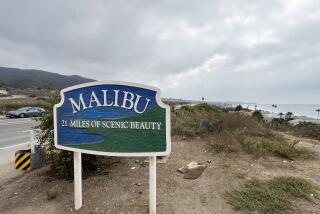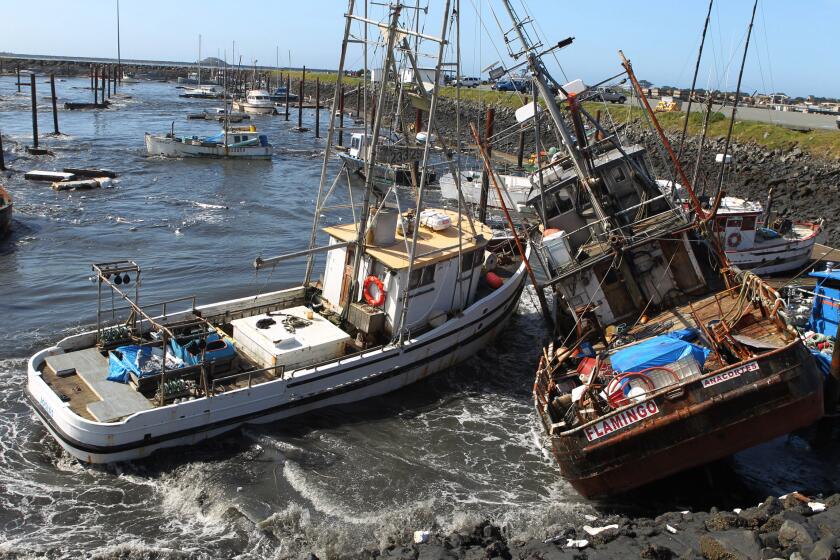Scientists Study San Andreas ‘Slip’ After July Quake
- Share via
Scientists have found evidence that parts of the southern San Andreas Fault “slipped” several days after a moderate quake struck north of Palm Springs in July--a possible sign that the 5.6 temblor may be a precursor of a large earthquake on the long-dormant portion of the fault.
No one is sure just what the unusual slippage means, scientists attending the annual meeting of the American Geophysical Union in San Francisco said Tuesday. But they said the slippage is unique in that it appears to be triggered by other quakes some distance from the area.
“Something is happening here that isn’t happening elsewhere,” said Caltech geologist Kerry Sieh, one of the foremost experts on the San Andreas Fault, which runs from the Gulf of Mexico to the Pacific Ocean north of San Francisco.
Drilling Near Fault
The report came as other geologists began drilling a hole 16,000 feet into the Earth’s crust near the fault in San Bernardino County’s Cajon Pass to learn more about fault zones and earthquake prediction.
The Cajon Pass project, the deepest hole ever drilled in the United States for scientific purposes, is about 20 miles north of San Bernardino and two miles north of the San Andreas Fault.
Mounted in a 200-foot-tall, white, blue and orange rig, the drill punctured the Earth’s crust at 2:45 a.m. Monday in a valley surrounded by the San Gabriel and San Bernardino mountains. By Tuesday morning it had reached a depth of 575 feet. Six weeks from now, it is expected to have bored down to 6,000 feet.
At that point, scientists from across the nation will converge on the spot and begin lowering “a wide sweep of sophisticated devices into the hole,” said Mark D. Zoback, 38, professor of geophysics at Stanford University and the project’s lead scientist.
“Out of that hole should come a lot of information--and surprises,” he said Tuesday. “That is the depth at which earthquakes begin to occur.”
The ambitious experiment is specifically designed to measure stress and temperature near an active fault zone--and to answer a mystery that has puzzled geologists for years about the fault.
“We know that friction exists in faults, and that friction should generate heat,” Zoback said. But in 15 years of study, “we’ve made over a hundred measurements on the San Andreas Fault looking for the heat and haven’t been able to find it.”
Meanwhile, land masses along either side of the fault in the Cajon Pass area have been moving in opposite directions at a rate of about an inch a year, accumulating stress in the process, Zoback said. If and when that stress is released, he said, the resulting earthquake could be of magnitude 7 or higher.
Funding for the $6-million project has been provided by the National Science Foundation. The research team organized to conduct the experiment includes 30 scientists from nine universities and the U.S. Geological Survey.
“This will provide a first-rate, three-dimensional look at Southern California’s crust,” said Lee Silver, a Caltech geologist and one of the participating researchers.
‘Accumulating Strain’
Zoback said drilling will continue in 1988, “when the money is expected to run out.” The southern segment of the fault, which runs from the Salton Sea into the San Bernardino Mountains, especially intrigues scientists because it is the only segment on the fault that has not produced a major quake during recorded history. That suggests that it may be past due for an earthquake that could devastate large sections of Southern California.
“We have every reason to believe it’s accumulating strain,” Sieh said at the San Francisco meeting.
Sieh described the southern leg as “long dormant yet an active structure” and said the fact that no major quake has struck that segment for at least 130 years “gives us concern.”
Sieh said historical records reveal that the 1906 earthquake that hit the San Francisco area was preceded by 15 or 16 years of seismic activity leading up to the catastrophic quake.
The Palm Springs quake on July 8 registered 5.6 on the Richter scale--although earlier reports put it slightly higher--and was centered on the San Andreas just north of the southern leg. In the aftermath of that quake, scientists fanned out along the San Andreas.
Patrick Williams, a geologist at Columbia University, said surface cracks appeared six days after the Palm Springs quake, and some were found more than 50 miles south of the epicenter.
‘Sympathetic Slips’
Such “sympathetic slips,” as Williams called them, were found near the Salton Sea and along the fault as it traverses the Indio Hills. Most of the slippage shows up as tiny cracks in the dirt along the fault, but Williams also found small “push-up ridges” that are caused by compression of the soil due to strain.
Sally Fagerson of Caltech said the southern leg of the San Andreas “appears to be the only segment that is creeping” because of “triggered slip” caused by other earthquakes.
That, along with its long period of dormancy, sets the southern leg apart from the rest of the San Andreas.
Fagerson said she and her Caltech colleagues found evidence of “three distinct creep events” at Mecca Beach on the edge of the Salton Sea. Recorders there found slippage 33 hours after the Palm Springs quake.
Louis Sahagun reported from Cajon Pass and Lee Dye from San Francisco.
More to Read
Sign up for Essential California
The most important California stories and recommendations in your inbox every morning.
You may occasionally receive promotional content from the Los Angeles Times.














